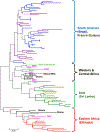Increasing proportions of relapsing parasite species among imported malaria in China's Guangxi Province from Western and Central Africa
- PMID: 34166802
- PMCID: PMC8429216
- DOI: 10.1016/j.tmaid.2021.102130
Increasing proportions of relapsing parasite species among imported malaria in China's Guangxi Province from Western and Central Africa
Abstract
Background: Travel-related malaria in non-endemic areas returning from endemic areas presents important challenges to diagnosis and treatment. Imported malaria to newly malaria-free countries poses further threats of malaria re-introduction and potential resurgence. For those traveling to places with high Plasmodium falciparum prevalence, prophylaxis against this parasite is recommended, whereas causal prophylaxis against relapsing malaria is often overlooked.
Methods: We analyzed a cluster of imported malaria among febrile patients in Shanglin County, Guangxi Province, China, who had recent travel histories to Western and Central Africa. Malaria was diagnosed by microscopy and subsequently confirmed by species- and subspecies-specific PCR. Plasmodium vivax was genotyped using a barcode consisting of 42 single nucleotide polymorphisms.
Results: Investigations of 344 PCR-confirmed malaria cases revealed that in addition to Plasmodium falciparum being the major parasite species, the relapsing parasites Plasmodium ovale and P. vivax accounted for ~40% of these imported cases. Of the 114 P. ovale infections, 65.8% and 34.2% were P. ovale curtisi and P. ovale wallikeri, respectively, with the two subspecies having a ~2:1 ratio in both Western and Central Africa. Phylogenetic analysis of 14 P. vivax isolates using a genetic barcode demonstrated that 11 formed a distinct clade from P. vivax populations from Eastern Africa.
Conclusion: This study provides support for active P. vivax transmission in areas with the predominant Duffy-negative blood group. With relapsing malaria making a substantial proportion of the imported malaria, causal prophylaxis should be advocated to travelers with a travel destination to Western and Central Africa.
Keywords: Central africa; Imported malaria; Plasmodium ovale; Plasmodium vivax; Relapses; West africa.
Copyright © 2021 Elsevier Ltd. All rights reserved.
Conflict of interest statement
Conflicts of interest
The authors affirm that they have no conflict of interest.
Figures


Similar articles
-
The increasing importance of Plasmodium ovale and Plasmodium malariae in a malaria elimination setting: an observational study of imported cases in Jiangsu Province, China, 2011-2014.Malar J. 2016 Sep 7;15(1):459. doi: 10.1186/s12936-016-1504-2. Malar J. 2016. PMID: 27604629 Free PMC article.
-
Diagnosis and Molecular Analysis on Imported Plasmodium ovale curtisi and P. ovale wallikeri Malaria Cases from West and South Africa during 2013-2016.Korean J Parasitol. 2020 Feb;58(1):61-65. doi: 10.3347/kjp.2020.58.1.61. Epub 2020 Feb 29. Korean J Parasitol. 2020. PMID: 32145729 Free PMC article.
-
Increasing number of imported Plasmodium ovale wallikeri malaria in Shandong Province, China, 2015-2017.Acta Trop. 2019 Mar;191:248-251. doi: 10.1016/j.actatropica.2019.01.015. Epub 2019 Jan 16. Acta Trop. 2019. PMID: 30659805
-
Comparison of Plasmodium ovale curtisi and Plasmodium ovale wallikeri infections by a meta-analysis approach.Sci Rep. 2021 Mar 19;11(1):6409. doi: 10.1038/s41598-021-85398-w. Sci Rep. 2021. PMID: 33742015 Free PMC article.
-
Misidentification of Plasmodium ovale as Plasmodium vivax malaria by a microscopic method: a meta-analysis of confirmed P. ovale cases.Sci Rep. 2020 Dec 11;10(1):21807. doi: 10.1038/s41598-020-78691-7. Sci Rep. 2020. PMID: 33311528 Free PMC article.
Cited by
-
Multidisciplinary Investigations of Sustained Malaria Transmission in the Greater Mekong Subregion.Am J Trop Med Hyg. 2022 Oct 11;107(4_Suppl):138-151. doi: 10.4269/ajtmh.21-1267. Print 2022 Oct 11. Am J Trop Med Hyg. 2022. PMID: 36228909 Free PMC article.
-
An imported malaria case with repeated episodes of neurological syndromes resulting from different Plasmodium species.BMC Infect Dis. 2024 Jan 3;24(1):41. doi: 10.1186/s12879-023-08872-y. BMC Infect Dis. 2024. PMID: 38172708 Free PMC article.
-
Population genomics of Plasmodium ovale species in sub-Saharan Africa.bioRxiv [Preprint]. 2024 Sep 19:2024.04.10.588912. doi: 10.1101/2024.04.10.588912. bioRxiv. 2024. Update in: Nat Commun. 2024 Nov 27;15(1):10297. doi: 10.1038/s41467-024-54667-3. PMID: 39345628 Free PMC article. Updated. Preprint.
-
Biochemical characteristics of patients with imported malaria.Front Cell Infect Microbiol. 2022 Nov 10;12:1008430. doi: 10.3389/fcimb.2022.1008430. eCollection 2022. Front Cell Infect Microbiol. 2022. PMID: 36439238 Free PMC article.
-
In vitro susceptibility profile of Plasmodium falciparum clinical isolates from Ghana to antimalarial drugs and polymorphisms in resistance markers.Front Cell Infect Microbiol. 2022 Oct 14;12:1015957. doi: 10.3389/fcimb.2022.1015957. eCollection 2022. Front Cell Infect Microbiol. 2022. PMID: 36310880 Free PMC article.
References
-
- Shretta R, Liu J, Cotter C, Cohen J, Dolenz C, Makomva K, et al.: Malaria Elimination and Eradication. In Major Infectious Diseases. Edited by rd, Holmes KK, Bertozzi S, Bloom BR, Jha P. Washington (DC)2017 - PubMed
-
- WHO: Eliminating malaria in the Greater Mekong Subregion: United to end a deadly disease. https://wwwwhoint/malaria/publications/atoz/eliminating-malaria-greater-....2016.
-
- Zhang S, Guo S, Feng X, Afelt A, Frutos R, Zhou S, et al.: Anopheles vectors in mainland China while approaching malaria elimination. Trends Parasitol. 2017;33:899–900. - PubMed
MeSH terms
Grants and funding
LinkOut - more resources
Full Text Sources
Medical

